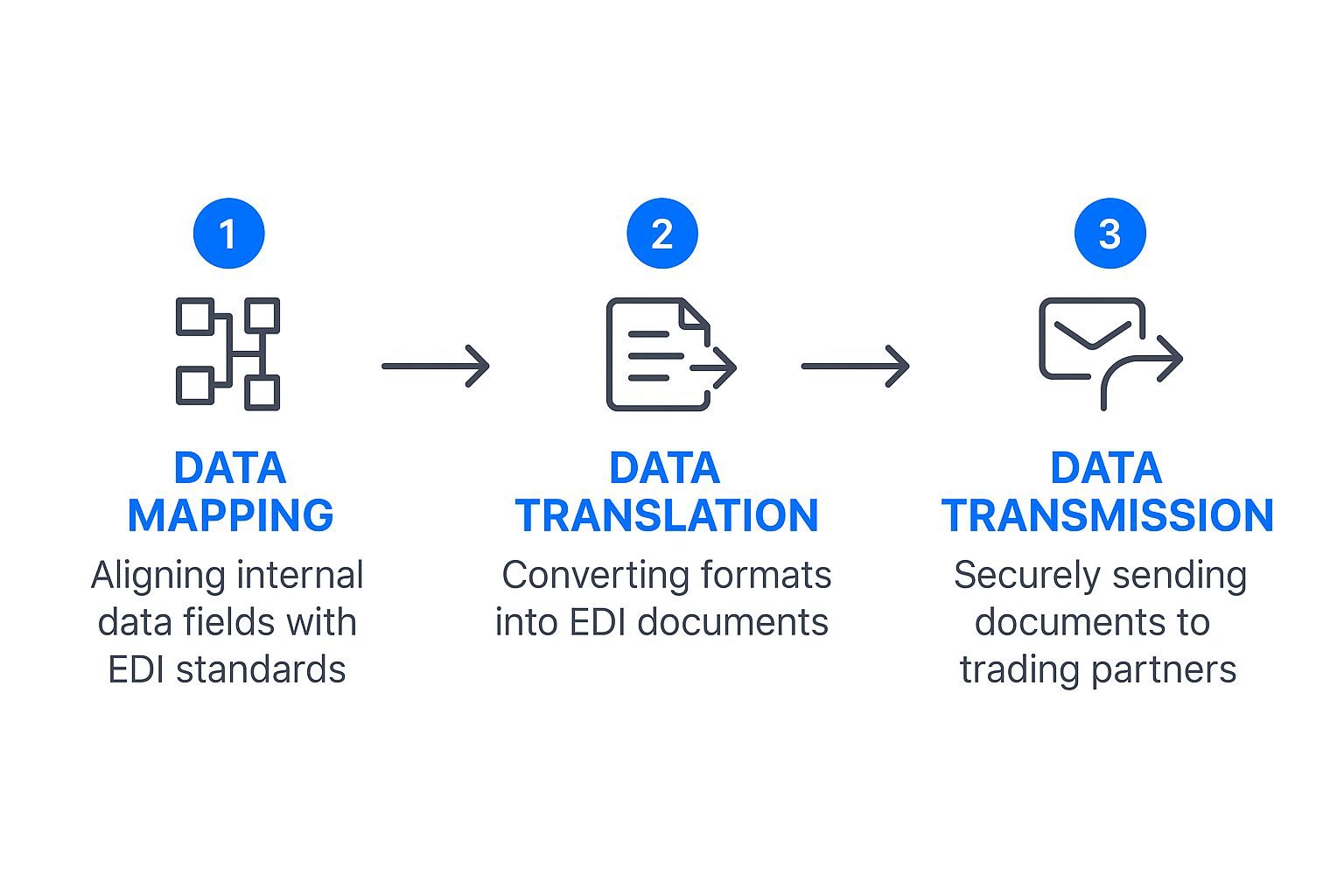EDI integration is about getting different business systems to speak the same language—automatically. Instead of someone manually typing in orders, it translates documents like purchase orders into a standard format and shoots them directly from one computer to another.
Think of it as a hyper-secure, automated digital courier service built specifically for business-critical information.

So, what’s EDI integration all about at its core? It’s about ditching slow, typo-prone manual work for a fast, standardized, and automated way to swap business documents.
Picture the old way: an employee gets a purchase order by email, manually keys that info into the company’s ERP system, prints an invoice, and sticks it in the mail. Every single one of those steps is a chance for human error—a mistyped product code, an incorrect shipping address, you name it.
EDI integration wipes those risks off the board. It acts as a direct bridge, connecting your business software straight to your trading partners' systems, whether they're suppliers, customers, or 3PLs. That connection enables a seamless, machine-to-machine exchange of structured data.
To make this less abstract, let’s follow the data as it moves from sender to receiver. The whole process hinges on a few key components working together to make sure the information is both standardized and sent securely. This automated flow is the key to understanding the real-world definition of Electronic Data Interchange (EDI).
This isn't some niche tech; it’s a cornerstone of modern global commerce. In fact, the market for Electronic Data Interchange is projected to hit $49.21 billion by 2027, a clear sign of its growing importance. This growth is all about the efficiencies it brings, from giving you real-time visibility into orders to getting new trading partners up and running faster.
The main goal of EDI is to create a common business language. It translates one company's internal data into a universally accepted standard so that a purchase order from their system is perfectly understood by another's, no matter what software they're running.
This standardization is what makes automation on a massive scale possible. Let's break down the components that make it all happen in a simple table.
This table breaks down the essential elements involved in a typical EDI document exchange, making the process easier to understand for beginners.
Each component plays a crucial role, from the initial translation of your data to its final, automatic entry into your partner's system, ensuring the entire process is fast, accurate, and completely hands-off.
So, what’s going on under the hood? Think of an EDI system as a hyper-efficient digital mailroom, one that ensures business documents get exactly where they need to go—securely and in an instant. This whole automated process boils down to three core stages that work together like a well-oiled machine.
It all starts with getting your internal business document ready for its journey. Let's say your accounting software just generated an invoice. The first step is called data mapping, which is really just about identifying the key pieces of information—like the customer name, product ID, and price—and getting them organized to fit into a universal EDI format.
Once your key data points are mapped out, the document moves into the translation phase. This is where an EDI translator acts like a universal interpreter, converting your company's unique data format into a standardized EDI document. Common examples you'll see are an EDI 810 (for an Invoice) or an EDI 850 (for a Purchase Order). This translation step is crucial because it guarantees your trading partner’s system can read the information perfectly, no matter what software they're using on their end.
This process basically turns your internal data into a common language for business transactions. The infographic below lays out this simple three-step workflow.

As you can see, the raw data is methodically mapped, translated into a standard format, and then securely transmitted. That final stage, data transmission, is the last piece of the puzzle.
After being translated, the standardized document is sent securely to your partner. This is typically done using a secure communication protocol like AS2 (Applicability Statement 2) or through a Value-Added Network (VAN). You can think of this as the digital equivalent of an armored truck, ensuring your critical business data is delivered safely and reliably.
Once it arrives, the whole process just happens in reverse. The partner's EDI system receives the document, translates it from the standard EDI format back into one their internal software understands, and automatically plugs it into their ERP or accounting system. No one has to lift a finger to type anything in.
This final backend integration is where you really see the magic of an EDI system. The entire cycle—from one company creating a purchase order to it appearing as a sales order in another's system—can happen in just minutes without any human intervention. It’s this tight, automated connection that slashes errors and dramatically speeds up the entire business cycle.
While EDI is the undisputed champ for handling structured, batch-based document exchanges, many modern businesses pair it with other technologies. To get the full picture on how real-time data exchanges work, take a look at our guide on API integration, which is the perfect complement to EDI in a modern tech stack.

Understanding the mechanics of EDI is one thing, but seeing its impact on the bottom line is what really matters. EDI integration moves beyond technical jargon to deliver tangible business wins, tackling the three biggest operational hurdles: cost, speed, and accuracy.
Imagine an employee manually keying in a large purchase order. A single mistyped SKU or an incorrect shipping address can send the wrong products out the door. The result? Costly returns, frustrated customers, and wasted hours trying to fix the mess.
EDI automation makes these human errors a thing of the past. By creating a direct, computer-to-computer link, it ensures the data you send is exactly what your partner receives. This dramatically improves accuracy across your entire supply chain.
In business, speed is money. The traditional order-to-cash cycle—the time it takes from receiving an order to getting paid—is often bogged down by manual document processing. Invoices get buried in inboxes, and shipping notices get delayed.
EDI crushes these bottlenecks. An electronic invoice can be sent and processed the moment an order ships, significantly shortening payment cycles and improving your company's cash flow. This newfound speed is a key component of effective order fulfillment automation, helping businesses scale without drowning in paperwork.
By automating routine document exchanges, your team is freed from tedious data entry. They can shift their focus from fixing errors to more strategic activities, like improving customer relationships or analyzing sales trends.
This isn't just about saving time; it's about reallocating your most valuable resource—your people—to tasks that actually drive growth.
Beyond the immediate savings and speed, EDI integration delivers a powerful strategic edge. It gives you the real-time data visibility needed to make smarter, faster decisions.
This enhanced visibility translates into several key benefits that strengthen your business from the inside out:
Ultimately, EDI integration isn't just an IT upgrade; it's a fundamental business improvement. It streamlines operations, strengthens partnerships, and provides the stable foundation needed to compete and thrive in a fast-paced market.
In the lightning-fast world of e-commerce, speed and accuracy aren't just goals—they're the entire game. This is where understanding what is EDI integration stops being a technical curiosity and becomes a core business strategy. Think of it as the invisible engine that powers a seamless online shopping experience, from the moment a customer clicks "buy" to the package landing on their doorstep.
Without it, retailers would be completely swamped, manually processing thousands of orders, trying to keep inventory straight, and coordinating with a dizzying number of suppliers and logistics partners. EDI creates the automated, standardized language needed to make high-volume retail not just possible, but profitable.
Let's trace a typical e-commerce purchase to see EDI in action. Imagine a customer orders a product from a major online retailer's website. That single click kicks off an immediate, automated chain reaction.
The Purchase Order (EDI 850): The retailer’s system doesn't shoot off an email to the supplier. Instead, it instantly generates and sends an EDI 850 (Purchase Order). This digital document pops up directly in the supplier's system, spelling out the product, quantity, and shipping details with zero human input.
The Advance Ship Notice (EDI 856): As soon as the supplier's warehouse packs the order, their system fires back an EDI 856 (Advance Ship Notice or ASN). This is a crucial update that says, "Hey, the order is on its way," and it's packed with tracking numbers and shipment specifics. The retailer's system grabs this data to automatically update the customer's order status.
The Invoice (EDI 810): Finally, the supplier’s accounting system sends an EDI 810 (Invoice) to the retailer’s accounts payable team. The retailer's system can then automatically match the invoice against the original purchase order and shipping confirmation, greenlighting the payment without anyone needing to manually review a thing.
This seamless, three-step dance ensures data moves between everyone involved instantly and accurately, stamping out the costly errors and frustrating delays that plague manual processes.
The payoff from this automated workflow is huge, especially as e-commerce keeps exploding. The global EDI software market was valued at around $2.08 billion in 2024 and is expected to climb to $5.30 billion by 2032. This growth isn't random; it's being pushed by industries like retail that absolutely depend on this level of automation to compete. You can explore more about the EDI market's growth and see just how dominant it is, with North America holding over 52% of the global share.
This deep reliance on EDI is what allows major retailers to juggle incredibly complex supply chains without dropping the ball.
For an e-commerce brand, EDI integration isn't a luxury anymore—it's the ticket to playing in the big leagues. It’s the key to maintaining accurate inventory, fulfilling orders at lightning speed, and building the kind of reliable, trustworthy customer experience that fuels real loyalty and growth.
By automating these fundamental document exchanges, businesses can process a massive volume of transactions with a small, highly efficient team. This frees them up to scale their operations, build stronger relationships with their suppliers, and focus on what really moves the needle: growing their brand.

It’s a common misconception that EDI is some dusty, old technology. The reality couldn’t be more different. Modern EDI is alive and kicking, constantly adapting to new tech to become more powerful and accessible than ever before. This evolution is really picking up steam on two major fronts: cloud computing and artificial intelligence.
The move to cloud-based EDI platforms has been a total game-changer. In the past, setting up an EDI system meant a huge upfront investment in servers and specialized IT staff, which locked out a lot of smaller businesses. Cloud EDI completely flips that script, offering a much more affordable, scalable, and manageable solution.
This shift is a huge part of how EDI integration is changing. Instead of wrestling with complex on-premise maintenance, businesses can now tap into cloud solutions that slash IT overhead and make it incredibly easy to connect with new trading partners around the globe.
The second major leap forward is the integration of Artificial Intelligence (AI) and machine learning. Think about it: EDI systems are constantly processing a massive flood of transactional data. That data is a goldmine of business insights just waiting to be discovered.
This is where AI comes in. AI algorithms can sift through all that information to spot trends, predict demand, and even flag potential supply chain hiccups before they turn into full-blown crises.
For instance, an AI-powered EDI system might notice a supplier is consistently late with their shipments and proactively suggest you adjust your order lead times. This transforms EDI from a simple document messenger into a strategic business intelligence tool. To dig deeper, you can learn more about unlocking the potential of AI in ecommerce in our dedicated article.
AI doesn't just analyze data; it automates complex decisions. By identifying patterns and anomalies in EDI transactions, AI can enhance operational responsiveness and provide a much clearer view of your entire supply chain.
Finally, let’s clear up a common point of confusion: EDI and APIs are not rivals. They’re actually complementary technologies that, when used together, create a far more powerful and flexible integration ecosystem.
It helps to think of them as two different tools for two different jobs.
By combining them, businesses get the best of both worlds. You get the structured reliability of EDI for all your core transactions and the real-time agility of APIs for those on-the-fly data needs. This powerful partnership is absolutely central to the future of how businesses communicate with each other.
Once businesses start digging into what EDI integration is, a bunch of practical questions always come up. Moving from the concept to actually getting it running means understanding the details, potential hiccups, and, of course, the costs. This section is all about tackling those common questions with clear, straightforward answers to help you make a smart decision.
We’ll get into the key differences between EDI and newer tools like APIs, point out the usual challenges you might face during setup, and break down what actually goes into the total cost of an EDI solution.
One of the first questions people ask is how EDI stacks up against an Application Programming Interface (API). While they both get computers talking and sharing data automatically, they’re built for different jobs. The best way to think about it is comparing a massive, formal shipping container to a quick, direct phone call.
The key takeaway here is that EDI and APIs aren’t rivals; they're teammates. EDI does the heavy lifting for all those structured, batch-based transactions, while APIs bring the real-time speed needed for modern apps. A really solid integration strategy often uses both.
Getting this distinction right is a big deal. Picking the right tool for the job saves you from a world of unnecessary complexity and makes sure your systems communicate efficiently, whether you're sending a batch of 1,000 invoices or just checking stock for a single product.
Let's be honest: setting up an EDI system is a major project. And just like any big operational shift, you can run into a few hurdles. Knowing what these are ahead of time can help you plan for a much smoother rollout.
The first big step is usually a meticulous process called data mapping. This is where you line up the data fields from your own systems (like your ERP) with the standardized fields required by EDI formats. It’s a make-or-break step for accuracy and can take a while, especially if your internal data isn’t perfectly organized.
Another common challenge is trading partner onboarding. Every partner you connect with might have slightly different rules or "implementation guides" for the specific EDI documents they use. Getting all those requirements coordinated across dozens or even hundreds of partners takes some serious project management to make sure everyone is on the same page and can communicate without errors.
Finally, you have to think about ongoing maintenance and what to do when things go wrong. Transactions can fail now and then because of data mistakes or network glitches. Having a clear process and either a dedicated team or a reliable managed EDI provider is critical for catching and fixing these issues fast, so they don’t disrupt your business.
There’s no single price tag for EDI integration; the cost can vary wildly depending on a few key things. Understanding these moving parts will help you budget the right way and pick a solution that actually fits your business.
The main cost drivers usually boil down to these four:
By really digging into these factors, you can get a much better handle on the total cost of ownership for an EDI solution and find a provider whose pricing model makes sense for where your company is headed.
Ready to eliminate manual data entry and streamline your supply chain with a reliable fulfillment partner? Simpl Fulfillment offers seamless EDI integration with all your e-commerce platforms and retail partners, ensuring your orders are processed with speed and accuracy. Focus on growing your brand and let us handle the logistics. Learn more about our EDI-capable fulfillment services.